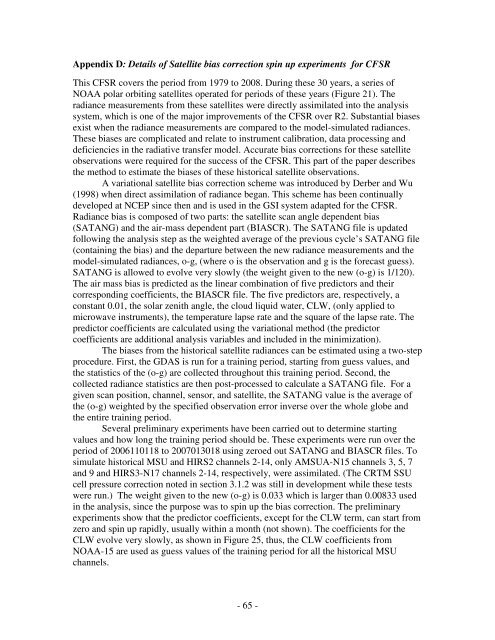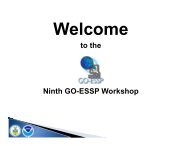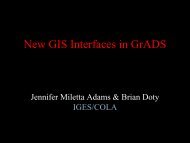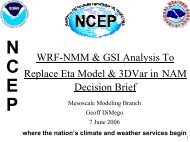The NCEP Climate Forecast System Reanalysis - NOAA National ...
The NCEP Climate Forecast System Reanalysis - NOAA National ...
The NCEP Climate Forecast System Reanalysis - NOAA National ...
You also want an ePaper? Increase the reach of your titles
YUMPU automatically turns print PDFs into web optimized ePapers that Google loves.
Appendix D: Details of Satellite bias correction spin up experiments for CFSRThis CFSR covers the period from 1979 to 2008. During these 30 years, a series of<strong>NOAA</strong> polar orbiting satellites operated for periods of these years (Figure 21). <strong>The</strong>radiance measurements from these satellites were directly assimilated into the analysissystem, which is one of the major improvements of the CFSR over R2. Substantial biasesexist when the radiance measurements are compared to the model-simulated radiances.<strong>The</strong>se biases are complicated and relate to instrument calibration, data processing anddeficiencies in the radiative transfer model. Accurate bias corrections for these satelliteobservations were required for the success of the CFSR. This part of the paper describesthe method to estimate the biases of these historical satellite observations.A variational satellite bias correction scheme was introduced by Derber and Wu(1998) when direct assimilation of radiance began. This scheme has been continuallydeveloped at <strong>NCEP</strong> since then and is used in the GSI system adapted for the CFSR.Radiance bias is composed of two parts: the satellite scan angle dependent bias(SATANG) and the air-mass dependent part (BIASCR). <strong>The</strong> SATANG file is updatedfollowing the analysis step as the weighted average of the previous cycle’s SATANG file(containing the bias) and the departure between the new radiance measurements and themodel-simulated radiances, o-g, (where o is the observation and g is the forecast guess).SATANG is allowed to evolve very slowly (the weight given to the new (o-g) is 1/120).<strong>The</strong> air mass bias is predicted as the linear combination of five predictors and theircorresponding coefficients, the BIASCR file. <strong>The</strong> five predictors are, respectively, aconstant 0.01, the solar zenith angle, the cloud liquid water, CLW, (only applied tomicrowave instruments), the temperature lapse rate and the square of the lapse rate. <strong>The</strong>predictor coefficients are calculated using the variational method (the predictorcoefficients are additional analysis variables and included in the minimization).<strong>The</strong> biases from the historical satellite radiances can be estimated using a two-stepprocedure. First, the GDAS is run for a training period, starting from guess values, andthe statistics of the (o-g) are collected throughout this training period. Second, thecollected radiance statistics are then post-processed to calculate a SATANG file. For agiven scan position, channel, sensor, and satellite, the SATANG value is the average ofthe (o-g) weighted by the specified observation error inverse over the whole globe andthe entire training period.Several preliminary experiments have been carried out to determine startingvalues and how long the training period should be. <strong>The</strong>se experiments were run over theperiod of 2006110118 to 2007013018 using zeroed out SATANG and BIASCR files. Tosimulate historical MSU and HIRS2 channels 2-14, only AMSUA-N15 channels 3, 5, 7and 9 and HIRS3-N17 channels 2-14, respectively, were assimilated. (<strong>The</strong> CRTM SSUcell pressure correction noted in section 3.1.2 was still in development while these testswere run.) <strong>The</strong> weight given to the new (o-g) is 0.033 which is larger than 0.00833 usedin the analysis, since the purpose was to spin up the bias correction. <strong>The</strong> preliminaryexperiments show that the predictor coefficients, except for the CLW term, can start fromzero and spin up rapidly, usually within a month (not shown). <strong>The</strong> coefficients for theCLW evolve very slowly, as shown in Figure 25, thus, the CLW coefficients from<strong>NOAA</strong>-15 are used as guess values of the training period for all the historical MSUchannels.- 65 -





